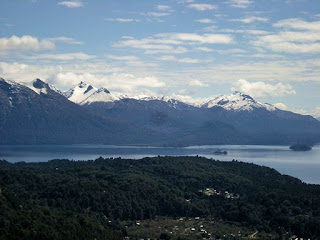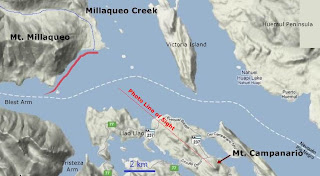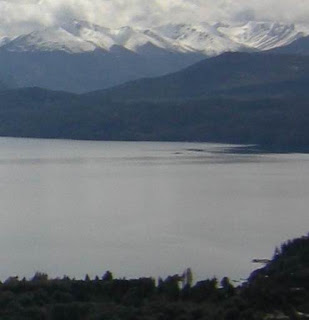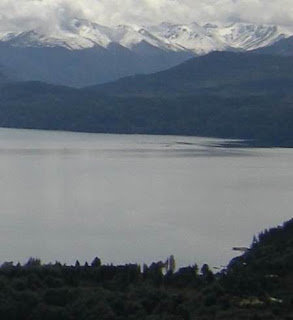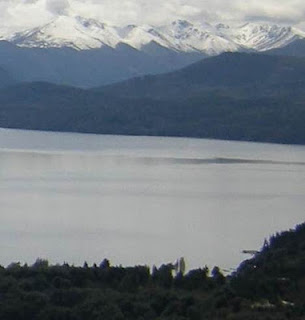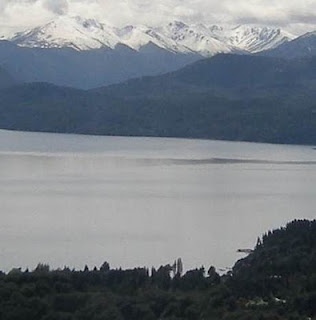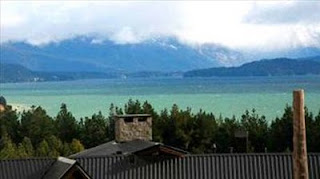I previous posts (List of my
plesiosaur entries) I have discussed
Nahuelito the "reptilian" cryptid that is said to live in Lake Nahuel Huapi. I have dismissed the possibility that the creature (if it exists) is an extant Mesozoic reptile, but I never gave a detailed explanation or proof to support my position. Until now.
Today we will look into the origin and evolution of Lake Nahuel Huapi and the mystery of a "lost" river in Patagonia. Both of which may shed some light on the plesiosaur business.
First there was fireThe mighty Andes are a mountain range that span the entire west coast of South America. They are being pushed upwards by the subduction of the Nazca Plate beneath the westward moving South American Plate. This is the longest subduction zone in the whole world and is over 7,000 km (4,350 mi.) long. This mighty collision shortens and crumples the South American Plate and forces the Andes constantly upwards.
The subduction process began during the late Mesozoic and early Cenozoic eras (at about the same time or shortly after the dinosaurs disappeared) and has continued since then. In the Patagonian Andes, which extend from roughly 39°S to 52°S, the uplift began during the Miocene period (23 to 5 Million years ago).
It was in this period that the area where modern Lake Nahuel Huapi lies was folded and driven upwards. Mighty mountain ranges were formed. These run with a North to South orientation and this conditioned regional drainage. Massive volcanos were also formed, and are still the highest mountains in the area (i.e Mount Tronador and Mount Lanin, both over 3,500 m – 11,500 ft.). These new mountains were much higher than they are nowadays, erosion had not yet worn them down. They had steep slopes and sharp "V" shaped valleys separated them.
Then there was iceRegular snow melt in summer and rain began the erosive process that created the first streams and rivers, which ran eastwards towards the Atlantic on the oriental side of the Andes, and west into the Pacific ocean on the occidental side. The continental water divide rested on the highest summits.
A proto-drainage system was formed. After several millions of years, a gradual cooling began, and the mountain tops began gathering more and more snow, which turned to ice and formed glaciers which then flowed downhill from these steep mountains into the valleys that separated them.
The glaciers, like gigantic bulldozers crunched the rock with their tremendous weight and abraded the valley floor and mountain slopes, making them wider and deeper and giving them the characteristic “U” shape of glacial valleys.
Ice age chronology at Nahuel HuapiThe first recorded Ice Age is the
Pichileufu Glaciation named after the Pichileufu River which runs some 20 km south east of Bariloche city in a northern direction towards Limay River.
Remains of glacial
drift (drift is any kind of rock transported by a glacier) have been found 350 to 500 meters above modern Lake Nahuel Huapi (up to 1,200 m above sea level – 3,900 ft.).
These glaciers were probably ice “lobes” that extended beyond the mountain range into the steppe, they were not very thick.[3]
This glaciation was followed by a long interglacial period during which the recently hewn glacial valleys were eroded by rainfall and rivers resulting in deeper and wider trenches. These would later serve as conduits for the glaciers during the following Ice Ages.[3]
The Andes in the meantime kept on pushing higher (1 – 0.8 million years ago) causing more ice to accumulate and defining the gradient along which ice would flow.
At about that time, the second glacial period (
El Cóndor began. It reached eastwards towards the Atlantic Ocean, along the steppe and west right up to the shores of the Pacific Ocean. Warming caused the glaciers to melt and retreat once more.
The final ice age or
Nahuel Huapi glaciation began some 75,000 years ago; the ice sheets reached their maximum coverage some 20,000 years ago, when once again warming caused the ice to melt. Sporadic “Tardiglacial” advances some 10,000 years ago (during the period known as
Younger Dryas in the Northern Hemisphere) puncutated the ice’s retreat.
Since then, the global warming trend has melted the valley glaciers in this area and permanent ice coverage can only be found on Mount Tronador (with several glaciers) and on the summits of other high mountains.[3]

Map showing extent of glacier coverage at Lake Nahuel Huapi. Copyright © 2007 by Austin Whittall. Adapted From [1].
Then there was waterIt is not easy to imagine extensive sheets of ice at least 2 km (1.25 mi.) thick moving slowly downhill towards what is now the edge of the Patagonian steppe, some 100 km (60 mi.) from the Continental Divide. These were massive glaciers whose flow was guided by the valleys formed during previous glaciations and the blocking effect of transversal (north-south) mountain ranges.
The west – east slope down which the glaciers moved was blocked by these north-south ranges. In some places such as the current basin of Lake Nahuel Huapi (like most Patagonian lakes it has an east-west orientation) the ice managed to leave the Andes behind and push outwards along the steppe.
Glacial Ice melt helped to form the paleo-valleys of most modern rivers draining towards the Atlantic, such as the Colorado, Negro, Neuquén and Limay rivers. These flowed along pre-existing faults (such as the Negro river along the Huincul fault) or along the proto-rivers that drained the area before the Ice Ages.
Towards the end of the last Ice Age some 16,000 to 18,000 years ago, ice melt generated huge quantities of water that were dammed in by the former glacier’s terminal moraine.
Moraines are crescent shaped mounds or accumulations of rocks that can be found at glacier’s tips and sides (frontal and lateral moraines), they are the rocks “bulldozed” by the advancing ice and act as dams to the melting glacial ice.
Water accumulated in the great depression that the glaciers had excavated, flooding the whole basin and forming a lake, which is known as
Elpalafquen (derived from the language of the local Mapuche natives:
Elpa = the beginning and
Lafquen = lake), the “lake of the beginning”.
Elpalafquen's water level was much higher than that of modern day Lake Nahuel Huapi and therefore this paleo-lake and covered a larger area than the current Lake Nahuel Huapi (which has a surface area of 550 km
2 or 212 sq.mi.).
It extended across current low-lying areas and meadows beyond what are now its shores, encompasing other lower lying lakes that now flow into Nahuel Huapi such as Lake Correntoso, Lake Espejo, Lake Moreno, Lakes Gutierrez and Mascardi among others.
Its eastern terminus was blocked by the natural dam of its terminal moraine. The excess water (melting snow on the surrounding mountains and rain) flowed over this moraine into what now is the Limay River and from there into the Negro River and on towards the Atlantic Ocean.
To the west, straddling the main Andean range, the melting ice cap still blocked the valleys that led to the Pacific Ocean. Later, a western outflow appeared along a paleo-River, the Lower Manso, which now drains part of this basin into the Pacific (the low lying Manso Pass, at 400 m above sea level [1,300 ft.] - 41º30’S, 71º50’W).
Breach and floodAbout 13,200 years ago, melting was accelerated during the Late Pleistocene period and probably a sudden volcanic or tectonic event created a cataclysmic breach of the eastern moraine. The dam broke and vast quantities of water poured downstream along the Limay paleo-River valley. [4]
The western end also lost its ice “plug” at the same time and contributed to drastically drop Elpalafquen's level.
The outflow had several consequences:
1. The paleo-lake split up into several smaller ones (that we can still see nowadays).
2. Nahuel Huapi, the largest among them continued flowing into the Atlantic. Lakes Gutierrez, Moreno and Correntoso -among others- flowed downstream into the Nahuel Huapi.
3. Other lakes (Mascardi, Guillermo, Steffen, Hess, Fonck, etc. changed their drainage westwards into the Pacific Ocean. The continental divide had moved east far from the highest mountains, an anomaly that would later create tension between Argentina and Chile when they defined their mutual border in the late 1800s.
4. Devastation along the Limay and Negro river valleys which may have contributed to give them their current shape.
Shorter route for the "Plesiosaur"Before this cataclysmic event it is very likely that Elpalafquen spilled east into the steppe, and that occasional large floods of glacial melt origin swept through that region. Perhaps it had a small outlet flowing due east with a constant flow.
There is an elevated region, with several ridges running north to south to the east of Lake Nahuel Huapi, these are the sources of several rivers, some that drain north into the Limay basin (Comallo and Pichi Leufu rivers), others south towards the Chubut basin and others west into Nahuel Huapi.
They are not to high (roughly 1,000 m – 3,300 ft.) so a flooded Elpalafquen could well have overflowed and washed across them draining into the lower lands that lie to the east and that currently drains into a closed basin (see my posts on this area's
Lake Carrilafquen, home to a "cuero" monster).
This idea was put forward by Casamiquela [2], who wrote about the geology of the Huahuel Niyeo River valley, which, according to him [2] is “
one of the stretches of the 'ancient Limay River Valley'”. He adds that this Limay paleo-river, instead of following its current SW-NE course, may drained eastwards and carried Andean rocks and gravel (“
rodados tehuelches”) into the area, during a “
great deglaciation”.
The gravel trailThese Patagonian gravels (known in Spanish as “
rodados patagónicos” or “
rodados tehuelches” cover most of the surface of Patagonia, it is a layer of gravel which can reach a thickness of tens of meters (hundreds of feet) composed of boulders and pebbles of a wide range of sizes.
which was first mentioned by Charles Darwin who was intrigued by them as he had seen them in northern Patagonia (by the Negro and Colorado rivers) and again in the south at Deseado and Santa Cruz rivers. He wrote:
By whatever means the gravel formation of Patagonia may have been distributed, the vastness of its area, its thickness, its superficial position, its recent origin, and the great degree of similarity in the nature of its pebbles all appear to me well deserving the attention of geologists, in relation to the origin of the wide-spread beds of conglomerate belonging to past epochs [5]
Darwin believed that in ancient times erosion (ice, water) had deposited vast amounts of pebbles at the foot of the Andes which were then spread out across Patagonia by the sea (wave action), which he believed covered most of Patagonia. As the continent rose, the gravel came above sea level.
Darwin's theory is not favored nowadays, but even today the origin of this gravel is debated. The general consensus is that they originated during the Pleistocene epoch, during the glaciations, which eroded and worked the rocks and boulders into these egg shaped stones. Water from ice melt (rivers, streams and floods) later dragged them across Patagonia.
As the following map shows, these gravels are found virtually everywhere and mostly following the courses of current rivers (the middle course of Chubut River as well as Limay and Neuquén rivers are exceptions. Why?). They are also found along the sea shore (perhaps due to oceanic dispersion of gravel washed into the ocean by the rivers).

Distribution of Patagonian Gravel and the hypothetical Elpalafquen river. Copyright © 2010 by Austin Whittall. Adapted from [7].
Did Eplalafquen drain eastwards along the northern foot of Somuncurá plateau in a broad arch through what are now closed basins fed streams that flowed north from the plateau? Could it have reached what is now the bay of San Antonio in the Gulf of San Matías?
The distribution of Patagonian gravel in the map shows that it may be possible (note the curved red line of the hypothetical river that drained Elpalafquen – shown as a red circle), furthermore it explains the gravel spread to the southeast of Elpalafquen.
There are some areas along the river's course that lack gravel (i.e. San Antonio on the Atlantic.) but here, marine transgression has placed sediment above the gravel.
The course of this river would roughly coincide with National Highway No. 23 and the Railroad that connects Bariloche with San Antonio Oeste. This is quite obvious as both road and tracks run along the lower lying areas north of Somuncurá plateau, which is where the river would have been in post-glacial times.
Somuncurá is home to a strange relict fish, the
naked minnow.
If so, this hypothetical river would have followed the course shown in red in the following map. I have also shown (red circle) the approximate area that the paleo-lake would have occupied and its southwestern drainage through the Manso River into Chile.

Elpalafquen's river draining towards the Atlantic. Copyright © 2010 by Austin Whittall
This river would have been very short lived (decades? centuries?) and when the Limay plug broke, the lower water level at Nahuel Huapi maked its end. Perhaps intermitent flow from Carilafquen paleo-lake could have kept it flowing for longer, but the link with the Andean lakes would have been severed.
Proof. The native myths.The native myth mentioned by Clemente Onelli in his 1903 book (he got it from first hand sources before the local natives traditions became lost forever). I will quote him fully:
I descended into a fertile and wide canyon that extends till it is out of sight towards the east and whose other tip, on the lake is now blocked by glacier hills; the native tradition says that, in very old times, along this gully a river flowed, it exited the lake [Nahuel Huapi] and reached the sea in front of the gulf of San Antonio [Gulf of San Matías]. [6]
Ancient maps offer additional proof, I will post on them in my next entry. By the way, there are several "missing" or "lost" rivers in Patagonia, I will post on them too.
The sea monsterHaving said all this, it could be reaonably possible this direct route along a hypothetical Elpalafquen drainage river would join the Ocean to the Andes. It would also be a far shorter than that of the Negro and Limay rivers. This is, I believe an interesting option and has some reasonable proof in its favor.
Now the "low probability" events:
If so, this Elpalafquen river could also have allowed some mysterious sea creature to swim upstream to the newborn glacial paleo-lake and make it its abode.
This would require an extant plesiosaur that somehow managed to survive extinction, reproduce and live in the oceans some 65 million years and then, during the small temporal window of this river's existence, find it and swim upstream to paleo-Lake Nahuel Huapi an adapt to a freshwater environment. Perhaps an impregnated female would suffice or to keep the species alive, a male and female couple would be required.
Yes, the chances of this happening are virtually nil.
Bibliography.[1] Kodama, K., Rabassas, J., Evenson, E., Clinch, M.(1986).
Paleomagnetismo y edad relativa del drift Pichileufu en su area tipo, San Carlos de Bariloche, Rio Negro. Asociación Geológica Argentina, Revista. XLI (1-2): 165-178. Fig. 1. pp. 167.
[2] Casamiquela, R., (1969).
Historia Geologica del Valle de Huahuel Niyeo Area Extraandina del Suroeste de la Provincia de Rio Negro, República Argentina (Con énfasis en el Pleistoceno). Asociación Geológica Argentina, Revista. Jul-Sep. pp. 287+
[3] Planas, F. (2009)
Las glaciaciones en el norte de la Patagonia Desde la Patagonia difundiendo saberes. V. 6 - Nº 9. Online.
[4] Del Valle, R., Tatur, A., Rinaldi, C. (2007)
Cambios en lagos y circulación fluvial vinculados al calentamiento climático del pleistoceno tardío-holoceno temprano en Patagonia e isla 25 de Mayo, islas Shetland del sur, Antártida. Revista de la Asociación Geológica Argentina 62 (4): 618- 626.
[5] Darwin, C., (1851).
Geological observations on coral reefs, volcanic islands and on South America: being the geology of the voyage of the Beagle, during the years 1833 to 1836. Smith, Elder & Co., pp. 25.
[6] Onelli, C.,
(2007). Trepando los Andes (1903. Buenos Aires: Ed. Continente. pp. 33
[7] Martinez, O., Rabassa, J., Coronato A., (2009).
Charles Darwin and the first scientific observations on the patagonian shingle formation (Rodados Patagónicos). Rev. Asoc. Geol. Argent. v.64 n.1 Buenos Aires abr. 2009
Further readingCaldenius, C. 1932.
Las glaciaciones cuaternarias en la Patagonia y T. del Fuego. Dir. Gral. Minas y Geología, Publ. 95, 150 pp., Buenos Aires
Feruglio, E. 1949-1950.
Descripcion geologica de la Patagonia. T.3, YPF, Buenos Aires
Fidalgo, F., 1982.
Glaciaciones en la Patagonia. INQUA Comm. Litol. & Genesis Quat. Depos., South Amer. Reg. Meet. Excursión Fieldbook, p. 9-29, J. Rabassa, de., Departamento de Geografia, Universidad Nacional del Comahue, Neuqu´n.
Rabassa, J. 1974.
Geologia de la región de Pilcaniyeu-Comallo, Pcia. de Río Negro, Argentina. Tesis doctoral N. 331, Facultad de Cienc. Nat. y Museo, Univ. Nac de La Plata y Publ. N. 17, Depto. Rec. Nat. Energia, Fundacion Bariloche: 128, San Carlos de Bariloche.
Patagonian Monsters -
Cryptozoology, Myths & legends in Patagonia2010 International Year of Biodiversity Copyright 2009-2010 by Austin Whittall ©

















